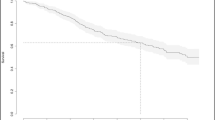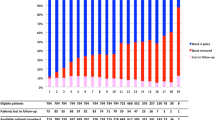Abstract
Background
Laparoscopic adjustable gastric banding (LAGB) has become one of the most common weight-loss procedures performed in the United States. The authors’ high-volume academic medical center has gathered a database of almost 3,000 patients who have undergone LAGB since January 2001. The goal of this series, the largest to date on LAGB outcomes at a single institution, was to assess complications associated with LAGB.
Methods
A retrospective analysis was performed using longitudinal data from adult patients who underwent LAGB between 1 January 2001, and 29 February 2008. General and band-related complications were reported for all patients. Death and reoperation for weight gain (LAGB followed by either a second band insertion or a gastric bypass) also were reported.
Results
Of the 2,965 patients who received LAGB during the study period, 2,909 met the criteria for inclusion in this analysis, and 363 (12.2%) experienced one or more complications. The most common complications were band slip (4.5%) and port-related problems (3.3%). Other complications were rare. Only seven patients (0.2%) had band erosion. Eleven patients (0.4%) underwent reoperation for weight gain. A total of 10 deaths (0.34%) occurred during the study period. Three patients died within 30 days of surgery. Two of these deaths (0.06%) were related to surgery, and one resulted from a motor vehicle accident. Seven patients died of causes unrelated to surgery during the course of the study.
Conclusions
The LAGB technique is a relatively safe procedure with few early or late complications. Few LAGB patients undergo reoperation for weight gain, and mortality is very rare.
Similar content being viewed by others
References
Centers for Disease Control (2008) State-specific prevalence of obesity among adults—United States, 2007. MMWR Morb Mortal Wkly Rep 57:765–768
Singhal R, Kitchen M, Bridgwater S, Super P (2008) Metabolic outcomes of obese diabetic patients following laparoscopic adjustable gastric banding. Obes Surg 18:1400–1405
Korenkov M, Shah S, Sauerland S, Duenschede F, Junginger T (2007) Impact of laparoscopic adjustable gastric banding on obesity comorbidities in the medium- and long-term. Obes Surg 17:679–683
Sjostrom L, Narbro K, Sjostrom CD, Karason K, Larsson B, Wedel H, Lystig T, Sullivan M, Bouchard C, Carlsson B, Bengtsson C, Dahlgren S, Gummesson A, Jacobson P, Karlsson J, Lindroos AK, Lonroth H, Naslund I, Olbers T, Stenlof K, Torgerson J, Agren G, Carlsson LM (2007) Effects of bariatric surgery on mortality in Swedish obese subjects. N Engl J Med 357:741–752
Biagini J, Karam L (2008) Ten years experience with laparoscopic adjustable gastric banding. Obes Surg 18:573–577
Chevallier JM, Zinzindohoue F, Douard R, Blance JP, Berta JL, Altman JJ, Cugnenc PH (2004) Complications after laparoscopic adjustable gastric banding for morbid obesity: experience with 1, 000 patients over seven years. Obes Surg 14:407–414
Fielding GA, Duncombe JE (2005) Clinical and radiological follow-up of laparoscopic adjustable gastric bands, 1998 and 2000: a comparison of two techniques. Obes Surg 15:634–640
O’Brien PE, Dixon JB, Laurie C, Anderson M (2005) A prospective randomized trial of placement of the laparoscopic adjustable gastric band: comparison of the perigastric and pars flaccida pathways. Obes Surg 15:820–826
Jan JC, Hong D, Bardaro SJ, July LV, Patterson EJ (2007) Comparative study between laparoscopic adjustable gastric banding and laparoscopic gastric bypass: single-institution, 5-year experience in bariatric surgery. Surg Obes Rel Dis 3:42–50
Biertho L, Steffen R, Ricklin T, Horber FF, Pomp A, Inabnet WB, Herron D, Gagner M (2003) Laparoscopic gastric bypass versus laparoscopic adjustable gastric banding: a comparative study of 1, 200 cases. J Am Coll Surg 197:536–544
Parikh MS, Laker S, Weiner M, Hajiseyedjavadi O, Ren CJ (2006) Objective comparison of complications resulting from laparoscopic bariatric procedures. J Am Coll Surg 202:252–261
Parikh MS, Fielding GA, Ren CJ (2005) U.S. Experience with 749 laparoscopic adjustable gastric bands: intermediate outcomes. Surg Endosc 19:1631–1635
Gulkarov I, Wetterau M, Ren CJ, Fielding GA (2008) Hiatal hernia repair at the initial laparoscopic adjustable gastric band operation reduces the need for reoperation. Surg Endosc 22:1035–1041
Ponce J, Paynter S, Fromm R (2005) Laparoscopic adjustable gastric banding: 1, 014 consecutive cases. J Am Coll Surg 201:529–535
Gagner M, Milone L, Yung E, Broseus A, Gumbs AA (2008) Causes of early mortality after laparoscopic adjustable gastric banding. J Am Coll Surg 206:664–669
Dolan K, Fielding G (2004) Biliopancreatic diversion following failure of laparoscopic adjustable gastric banding. Surg Endosc 18:60–63
Acknowledgments
We thank Analytica International. Allergan provided financial support for portions of this research.
Disclosures
Dr. Carelli and Ms. Youn have no conflicts of interest or financial ties to disclose. Marina S. Kurian has received grants and honoraria from Allergan Health. Dr. Ren and Dr. Fielding received research and educational grants from Allergan Health and they also on the advisory board for Allergan Health and received speaker honorariums.
Author information
Authors and Affiliations
Corresponding author
Rights and permissions
About this article
Cite this article
Carelli, A.M., Youn, H.A., Kurian, M.S. et al. Safety of the laparoscopic adjustable gastric band: 7-year data from a U.S. center of excellence. Surg Endosc 24, 1819–1823 (2010). https://doi.org/10.1007/s00464-009-0858-8
Received:
Accepted:
Published:
Issue Date:
DOI: https://doi.org/10.1007/s00464-009-0858-8




